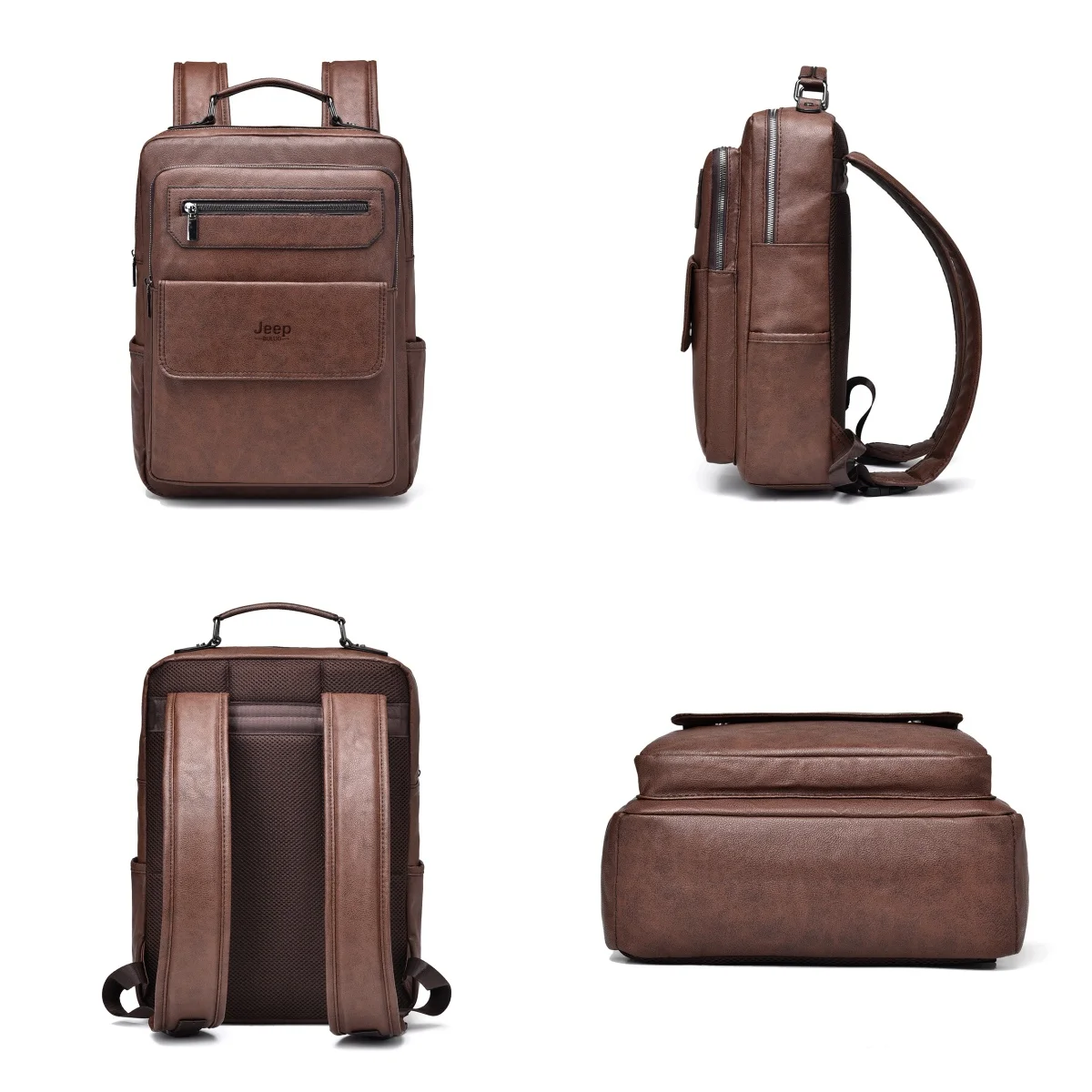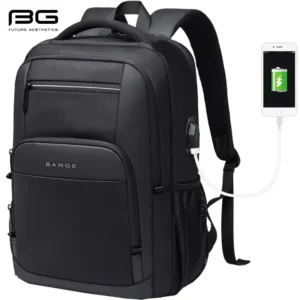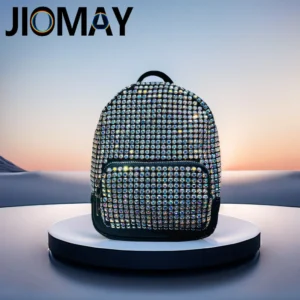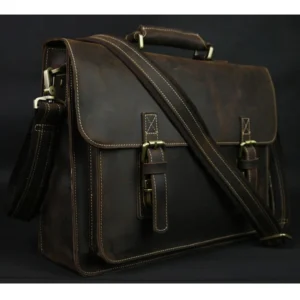Introduction
The college experience demands a backpack that can keep up with both your busy schedule and your personal style. Leather backpacks offer that perfect combination of durability and fashion that many students seek. Unlike synthetic alternatives that wear out after a few semesters, a quality leather backpack develops a rich patina over time, becoming more uniquely yours with each passing day.
For students navigating between lecture halls, study sessions, and social activities, the right leather backpack provides more than just a way to carry books—it makes a statement about your personal style while offering practical functionality that adapts to your changing needs. The best part? A well-made leather backpack can transition seamlessly from your campus days to your professional life after graduation.
In today’s competitive academic environment, standing out while staying practical requires thoughtful choices in your everyday accessories. Understanding the perfect leather backpack for campus environments means considering not just appearance, but also organization, comfort, and longevity.
This guide will walk you through everything you need to know about selecting a fashionable leather backpack that works hard for your student lifestyle—from understanding different leather qualities and essential features to styling tips and proper care routines that ensure your investment lasts throughout your academic journey and beyond. When chosen wisely, the leather backpacks you select today could become your trusted companion for years to come.
Understanding Student Needs in a Fashionable Backpack
Today’s students face unique challenges that their backpacks must address. Between carrying laptops, tablets, textbooks, notebooks, and personal items, the modern student needs a backpack that balances style with serious functionality. Current backpack trends among college students tend to fall into three main categories:
- Minimalist designs: Clean lines, subtle branding, and understated elegance
- Vintage-inspired styles: Classic silhouettes with modern updates for technology
- Modern utility: Contemporary designs with innovative organizational features
The typical student carries between 10-20 pounds of items daily, often switching between different campus buildings throughout the day. This creates unique wear patterns and stress points that fashion-only bags simply can’t handle.
Additionally, many students now balance class time with internships or part-time jobs, requiring a backpack that transitions appropriately between these environments. A backpack that looks out of place in a professional setting can become a liability for students trying to make strong first impressions.
The right student-friendly leather bag features combine aesthetics with practical elements like padded laptop compartments, water bottle holders, and quick-access pockets for items needed throughout the day. As students move between classroom, library, coffee shop, and sometimes professional settings, their backpacks must adapt accordingly.
What works for a humanities major carrying books might differ from an architecture student transporting models and drafting materials. Understanding your specific needs is the first step in finding a leather backpack that truly works for your student lifestyle. The best choices offer flexibility while maintaining the fashion-forward appearance that helps you express your personal style on campus.
For tech-focused students, specialized leather laptop backpacks provide extra protection and organization for valuable electronics while maintaining a fashionable appearance.
Key Design Elements That Define “Fashionable” for Students
What makes a leather backpack truly “fashionable” for today’s student? Several key design elements contribute to a backpack’s aesthetic appeal while maintaining its functionality:
Silhouette and Structure
– Slim profiles with clean lines for a sophisticated urban look
– Structured designs that maintain their shape even when not full
– Balanced proportions that complement different body types
Hardware Elements
– Antiqued brass or brushed silver hardware for a premium appearance
– Quality zippers with smooth action and distinctive pulls
– Understated buckles and clasps that serve both functional and decorative purposes
Color Palettes
– Classic neutrals: rich browns, deep blacks, and navy tones that match everything
– Subtle statement colors: burgundy, forest green, or charcoal that add personality
– Two-tone designs that create visual interest without overwhelming
Leather Finishes
– Full-grain with natural variations that develop character over time
– Lightly pebbled textures that hide minor scratches from daily use
– Semi-gloss finishes that balance casual and professional appearances
Successful stylish leather backpacks for college environments find the perfect balance between making a style statement and blending in appropriately. The most versatile designs incorporate subtle branding rather than obvious logos, allowing the quality of materials and craftsmanship to speak for themselves.
What’s considered fashionable also varies between campus cultures—East Coast universities might favor more traditional, heritage-inspired designs, while West Coast schools might embrace more relaxed, innovative styles. Understanding your campus culture can help you select a backpack that feels both personally expressive and contextually appropriate.
Essential Student-Friendly Features
Beyond style, several practical features distinguish truly student-friendly backpacks from those that merely look good:
Storage Capacity
– Main compartment large enough for multiple textbooks (typically 18-22 liters)
– Ability to expand slightly to accommodate varying daily loads
– Balanced capacity that prevents overpacking and excessive weight
Advanced Organization
– Padded laptop compartment with secure closure
– Multiple internal pockets for smaller items (pens, calculators, chargers)
– Front quick-access pocket for frequently needed items
– Hidden security pocket for valuables (wallet, ID, keys)
Comfort Features
– Padded, contoured shoulder straps that distribute weight evenly
– Breathable back panel to prevent overheating during long days
– Balanced weight distribution that reduces strain on shoulders and back
– Optional sternum strap for heavier loads
Durability Considerations
– Reinforced bottom panel to prevent wear from frequent setting down
– Double stitching at stress points where straps connect to the bag
– Quality interior lining that won’t tear or separate from the outer material
Organizing textbooks in leather backpacks requires thoughtful compartmentalization that prevents damage to both the books and the backpack itself. The most effective designs consider not just static storage but the dynamic needs of students accessing materials throughout their day.
Weather resistance is another crucial consideration for students who travel between buildings in various conditions. A well-designed leather backpack should include weather-resistant zippers, treated leather, or even subtle protective flaps that keep contents dry without compromising the bag’s aesthetic appeal.
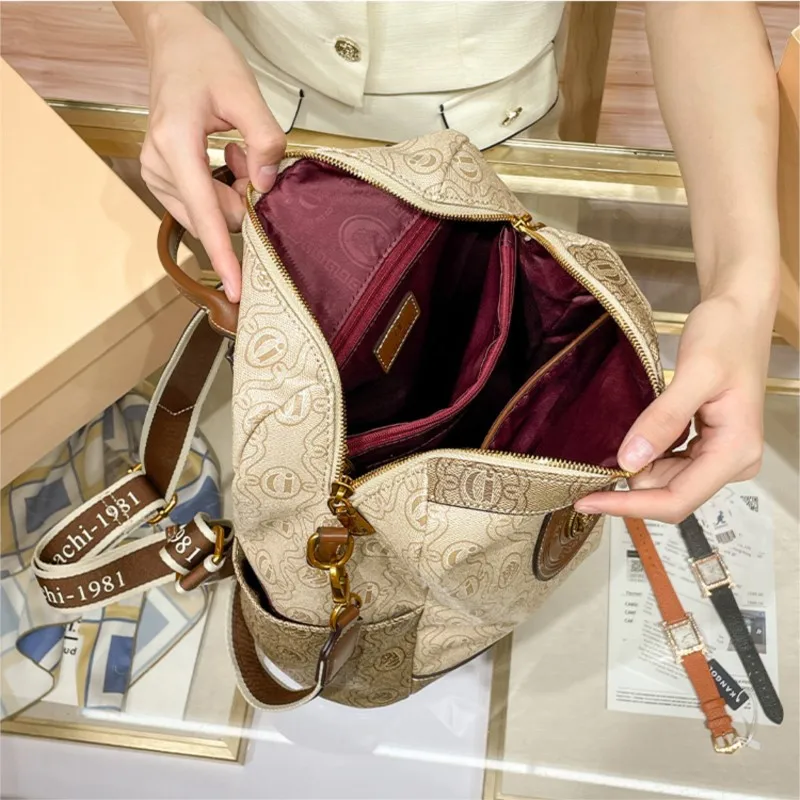
Understanding Leather Quality: Making a Smart Investment
When shopping for a leather backpack as a student, understanding quality differences becomes crucial to making a smart investment. While the higher initial cost of quality leather might seem daunting on a student budget, the long-term economics make a compelling case: a $300 premium leather backpack used daily for five years costs just 16 cents per use—significantly less than replacing $60 synthetic backpacks every semester.
Quality leather backpacks offer several advantages for students:
- Longevity: Premium leather can last 10+ years with proper care
- Aging characteristics: Develops unique patina that improves appearance over time
- Repair potential: Can be professionally restored rather than replaced
- Resale value: Quality leather maintains value better than synthetic materials
Beyond practical considerations, there are ethical and environmental factors to consider. Fast-fashion synthetic backpacks contribute to landfill waste, while responsibly sourced leather products can last decades. Many premium leather companies now emphasize sustainable tanning processes that minimize environmental impact.
The differences between full-grain versus top-grain leather significantly impact both appearance and durability. Understanding these distinctions helps students make informed decisions that align with both their budget constraints and long-term value expectations.
When selecting a leather backpack, look for companies that are transparent about their sourcing and production methods. Many premium manufacturers now highlight their sustainable practices, from natural tanning processes to responsible material sourcing. For students concerned about environmental impact, these full-grain leather backpacks represent not just a fashion choice, but a sustainable decision that reduces overall consumption.
The Hierarchy of Leather Types for Backpacks
Not all leather backpacks are created equal. The type of leather used dramatically affects durability, appearance, and value. Understanding this hierarchy helps students make informed decisions:
Full-Grain Leather (Premium Quality)
Full-grain leather represents the highest quality available, made from the top layer of the hide with its natural grain intact. This leather:
– Contains natural variations and markings that create character
– Develops a beautiful patina over time that enhances its appearance
– Offers the greatest durability and resistance to wear
– Provides natural water resistance that improves with proper conditioning
– Typically lasts 10-20+ years with proper care
The natural grain acts as a protective layer, making full-grain leather backpacks exceptionally resistant to daily wear. Though the highest priced option, full-grain represents the best long-term value for students who can make the initial investment.
Top-Grain Leather (High Quality)
Top-grain leather comes from the upper portion of the hide, but has been sanded to remove imperfections and stamped with a uniform grain pattern:
– Offers more consistent appearance than full-grain
– Provides good durability though not as exceptional as full-grain
– Develops some patina over time, though less distinctive
– Typically lasts 5-10 years with proper care
– Comes at a more accessible price point than full-grain
For students balancing budget with quality, top-grain leather provides an excellent middle ground, offering many premium characteristics at a more accessible price point.
Genuine Leather (Standard Quality)
Despite its name suggesting authenticity, “genuine leather” actually indicates the third tier of leather quality:
– Made from lower layers of the hide after top layers are removed
– Often treated heavily with dyes and finishes to mask inconsistencies
– Shows wear more quickly than higher grades
– Typically lasts 2-5 years before showing significant wear
– Represents an entry-level price point for real leather
Genuine leather backpacks can serve as an introduction to leather goods for students on tight budgets, but won’t offer the same longevity as higher grades.
Bonded Leather (Lowest Quality)
Bonded leather is manufactured by shredding leather scraps and bonding them with adhesives:
– Contains only 10-20% actual leather content
– Prone to peeling and cracking, especially at flex points
– Typically lasts only 1-2 years with regular use
– Cannot be repaired once deterioration begins
– Represents the lowest price point for “leather” products
Students should generally avoid bonded leather backpacks despite their attractive pricing, as they often fail during a single academic year.
Vegan/Faux Leather Alternatives
For students with ethical concerns about animal products, several alternatives exist:
– PU (polyurethane) leather offers a similar appearance with no animal products
– Cork-based materials provide eco-friendly alternatives with unique textures
– Canvas-leather combinations reduce leather content while maintaining durability
– Pineapple leaf fiber (Piñatex) creates innovative leather-like material
When comparing leather versus canvas student bags, each material offers distinct advantages. Canvas provides lightweight durability and often lower cost, while leather offers superior weather resistance, professional appearance, and typically longer lifespan. Many students find that hybrid bags combining both materials offer an ideal balance.
Essential Features That Make a Leather Backpack Student-Perfect
The perfect leather backpack for students balances aesthetic appeal with practical features that address daily campus challenges. Different academic programs create varied demands—art students need space for portfolios and supplies, while engineering students might need specialized compartments for calculators and tools.
Campus geography also affects backpack requirements. Students at sprawling universities who walk miles between classes prioritize comfort features, while those at compact urban campuses might emphasize security elements and weather protection. The distance between your residence and classes, frequency of public transportation use, and typical daily schedule all influence which features deserve priority in your backpack selection.
Consider your personal study habits as well—if you frequently transition between library, coffee shop, and home, accessibility and organization become paramount. If you carry valuable technology, protection features gain importance. When evaluating backpacks, assign priority levels to features based on your specific student experience rather than general recommendations.
Most importantly, a student backpack should adapt to changing needs throughout your academic career. Courses change, study habits evolve, and professional requirements emerge as you approach graduation. The most valuable leather school bags with laptop compartments offer adaptability that accommodates these transitions without requiring replacement.
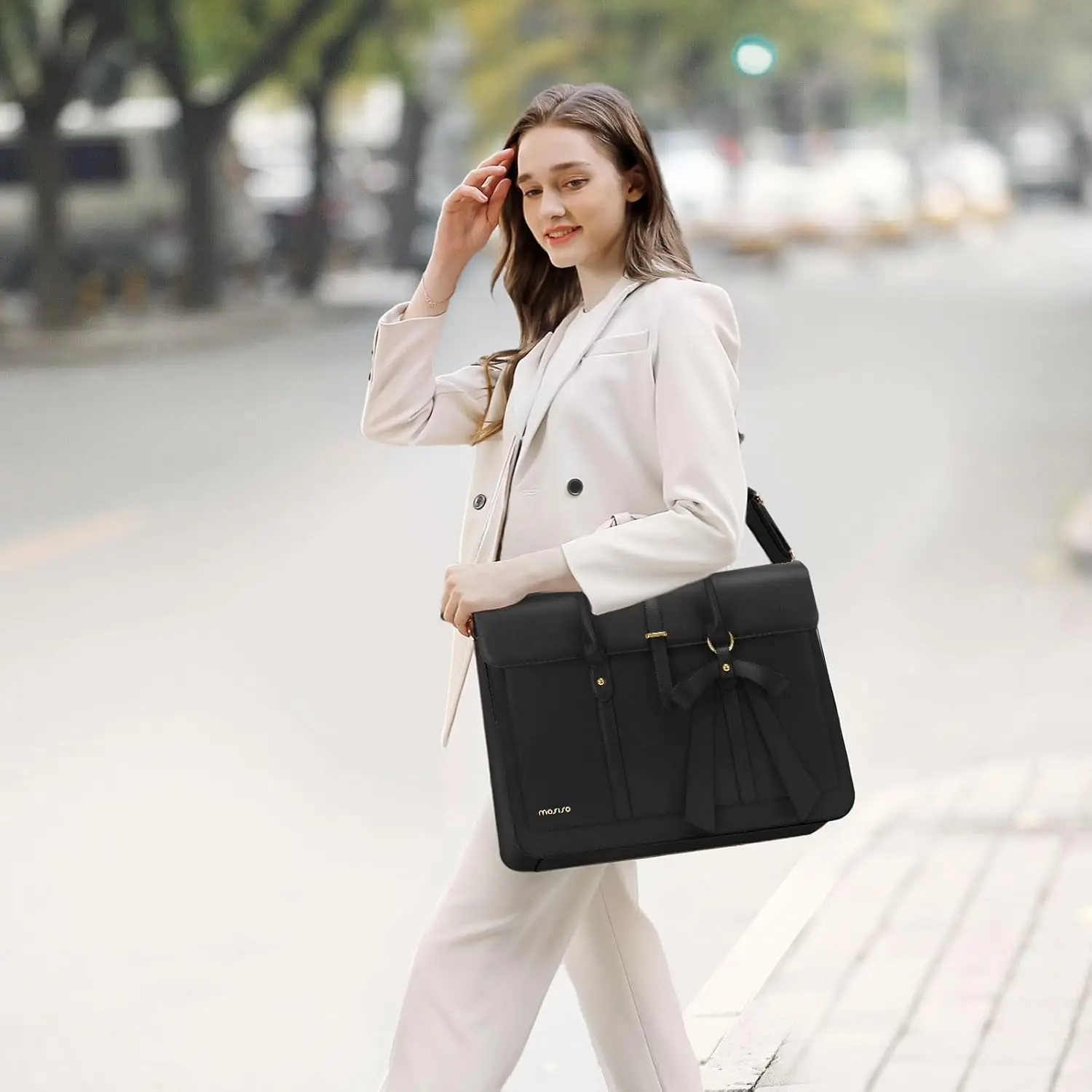
Smart Organization: Compartments That Work for Students
Effective organization transforms a backpack from simple storage to productivity tool. The most student-friendly designs include:
Main Storage Compartment
– Capacity: 18-22 liters (sufficient for multiple textbooks)
– Wide opening: Allows easy viewing of all contents
– Light-colored lining: Increases visibility of small items
– Structured sides: Prevents collapse when partially empty
Laptop Protection
– Dedicated padded compartment: Fits devices up to 16”
– Elevated bottom padding: Creates protection from setting bag down
– Secure closure: Prevents laptop from shifting during movement
– Microfiber lining: Prevents scratches on device surfaces
Strategic Secondary Pockets
– Front quick-access pocket: For phone, ID card, transit pass
– Side water bottle pocket: Ideally elasticized to secure contents
– Interior zippered pocket: For valuable items requiring security
– Mesh organizer pockets: For pens, cables, and small accessories
Technology Accommodation
– Cable pass-through ports: Allow charging while items remain in bag
– Dedicated tablet sleeve: Separate from main laptop compartment
– Power bank pocket: With cable routing to devices
– Headphone hook or pocket: Keeps audio accessories accessible
The most effective organized compartments in leather backpacks are designed with student workflows in mind. For example, placing quick-access items near the top prevents digging through the main compartment, while keeping related items grouped together (charging cable near laptop sleeve) streamlines daily use.
Strategic compartmentalization also protects items from each other—separating water bottles from electronics, keeping sharp objects away from screens, and isolating potentially messy items from important papers. The best organizational systems aren’t just about having many pockets but having the right pockets in the right places for student needs.
Comfort-Focused Design Elements
Even the most stylish backpack becomes useless if it causes discomfort during long days on campus. Key comfort features to look for include:
Shoulder Strap Design
– Width: Minimum 2 inches (5cm) to distribute weight properly
– Padding: High-density foam that resists compression
– Contoured shape: Follows natural shoulder curvature
– Adjustability: Allows customization for different body types and heights
Back Panel Construction
– Ergonomic padding: Supports natural spine curvature
– Air channels: Promotes ventilation to prevent overheating
– Memory foam: Conforms to body for personalized comfort
– Lumbar support: Reduces lower back strain during extended wear
Weight Distribution Features
– Sternum strap: Prevents shoulder straps from sliding outward
– Balanced design: Centers weight close to the body
– Load lifter straps: On larger models to adjust weight positioning
– Compression straps: Stabilize contents to prevent shifting
Understanding proper backpack weight distribution techniques is essential for preventing both short-term discomfort and long-term back problems. Experts recommend that loaded backpacks should not exceed 10-15% of body weight, though many students regularly carry more. This makes comfort features even more crucial.
Comfort should never be sacrificed for style—the best backpacks integrate comfort features discreetly without disrupting the clean aesthetic of premium leather. For example, contoured shoulder straps can be made from the same leather as the bag, with padding hidden underneath rather than exposed as on more technical packs.
Hardware and Construction Quality Indicators
The difference between a backpack that lasts one year versus one that lasts through your entire degree often comes down to hardware and construction details:
Zipper Quality
– YKK or equivalent branded zippers: Industry standard for reliability
– Metal rather than plastic: Provides greater durability at stress points
– Self-healing design: Realigns teeth if zipper catches
– Smooth action: Indicates proper installation and quality mechanism
– Weather-resistant coating: Prevents water intrusion at closures
Buckle and Clasp Considerations
– Metal versus plastic: Metal offers superior strength but adds weight
– Secure locking mechanism: Prevents accidental opening
– Stress-tested materials: Resists cracking under repeated use
– Smooth operation: Indicates quality manufacturing
Stitching Techniques
– Double or reinforced stitching: At all stress points and handles
– Consistent stitch length: Indicates machine precision
– Backstitching at stress points: Prevents unraveling if one stitch breaks
– Thread quality: Bonded nylon or polyester resists wear and UV damage
Stress Point Reinforcement
– Rivets or extra stitching: Where straps connect to the bag body
– Reinforced bottom panel: Prevents wear from frequent setting down
– Corner protection: In areas most likely to contact surfaces
– Handle attachment: Should distribute weight across wider area
For students who need durable leather bags for daily classes, these construction details make the difference between a disposable item and a lasting investment. When examining potential backpacks, pay special attention to these less obvious quality indicators rather than focusing exclusively on the leather itself.
Interior lining quality also plays a crucial role in durability—cheap linings tear easily and separate from the leather exterior. Look for firmly anchored linings made from rip-stop nylon or similar materials that resist abrasion from textbooks and other contents.
Top 8 Fashionable Leather Backpacks for Student Life
After analyzing dozens of leather backpacks against our comprehensive criteria for style, functionality, durability, and value, we’ve selected eight standout options that meet the diverse needs of today’s students. Each recommendation balances fashion-forward design with practical features essential for campus life.
Our selection methodology prioritized backpacks that:
– Demonstrate exceptional quality-to-price ratio
– Offer features specifically beneficial to student lifestyles
– Provide versatility across different campus settings
– Maintain style relevance beyond temporary trends
– Represent different aesthetic approaches to student fashion
These recommendations span various price points, styles, and functional priorities to accommodate different student needs and preferences.
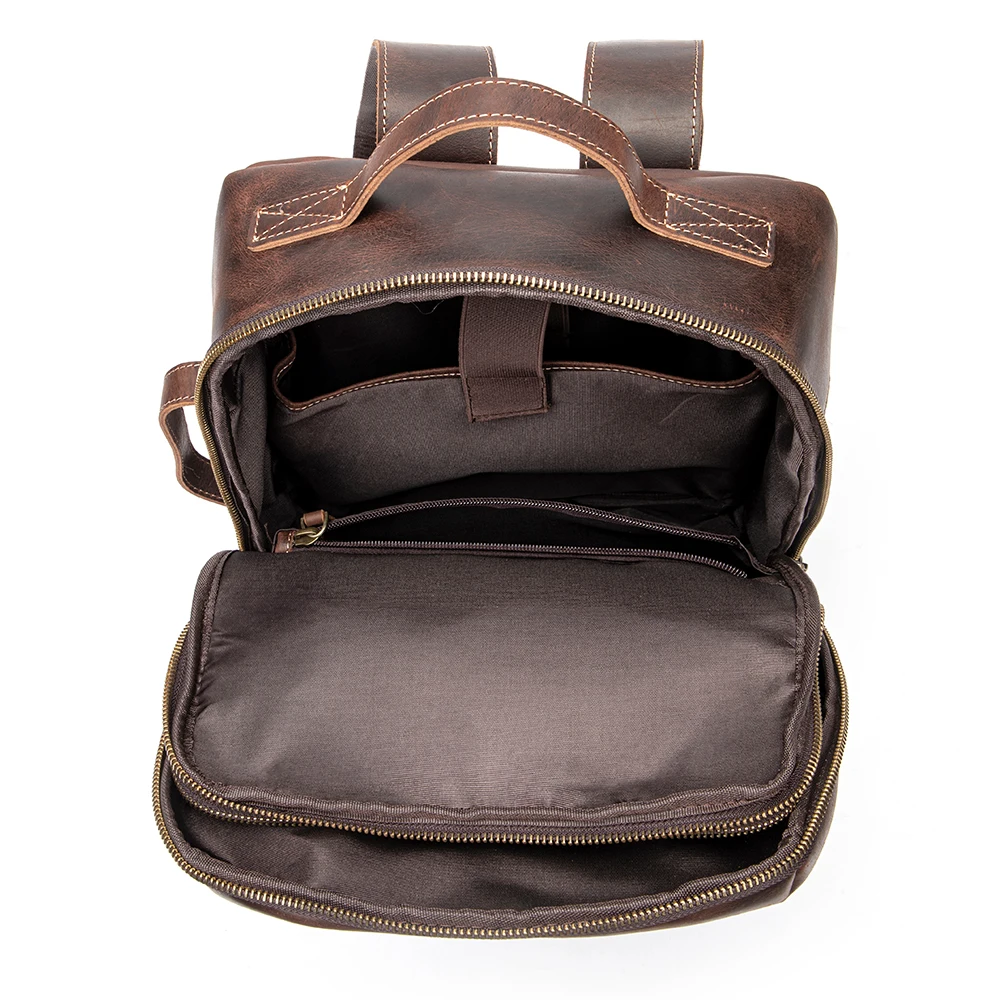
Best Minimalist Design for Everyday Campus Use
For students who appreciate clean lines and understated elegance, the minimalist leather backpack offers sophisticated simplicity that works seamlessly with any wardrobe. This style emphasizes quality materials and thoughtful design over flashy details.
Key features include:
– Streamlined silhouette free of unnecessary decorative elements
– Single main compartment with hidden organizational features
– Padded laptop sleeve accommodating devices up to 15 inches
– Premium full-grain leather that develops character over time
– Discreet exterior pocket for frequently accessed items
– Contoured shoulder straps with hidden padding for comfort
– Magnetic closure with minimal visible hardware
– Available in neutral tones (black, chestnut, navy)
The beauty of this design lies in its versatility—it pairs equally well with casual jeans and a t-shirt or more polished attire for presentations or interviews. The absence of visible branding or trendy details ensures this backpack remains relevant throughout your academic career and beyond.
Despite its sleek appearance, this backpack accommodates daily essentials including a 15” laptop, several books, notebooks, and personal items. The internal organization system includes designated spaces for smaller items without disrupting the clean exterior lines.
For students seeking timeless style with modern functionality, these vintage leather backpacks offer the perfect solution—classically inspired designs updated for contemporary campus needs.
Best Vintage-Inspired Design with Modern Functionality
Students drawn to heritage aesthetics will appreciate vintage-inspired backpacks that combine classic design elements with thoughtful updates for today’s technology demands. These bags reference traditional craftsmanship while acknowledging contemporary needs.
Key features include:
– Traditional flap-over design with modern magnetic closures
– Burnished leather finish that accelerates the patina development process
– Brass hardware with antique finish for authentic vintage appearance
– Modern laptop compartment hidden within traditional design
– Side-access zipper for quick technology retrieval
– Reinforced leather bottom panel for durability
– Adjustable shoulder straps with comfort padding
– Heritage color options (tobacco brown, oxblood, tan)
These backpacks excel at bridging different worlds—they look appropriate in both casual campus settings and more formal environments. The intentional aging of the leather gives a lived-in appearance from day one, while still allowing for the development of personal wear patterns over time.
The clever integration of modern features preserves the vintage aesthetic while addressing contemporary needs. For example, hidden laptop protection appears seamless from the exterior, and internal organization maintains the classic appearance while accommodating modern essentials like smartphones, tablets, and electronic accessories.
These vintage-inspired leather backpack designs appeal to students who appreciate historical references and timeless style but still require full functionality for academic demands.
Best Professional-Looking Backpack for Internship Transitions
As students progress through their academic careers, many begin balancing classroom time with professional internships or job interviews. This transitional backpack projects maturity and competence while maintaining practical functionality for academic requirements.
Key features include:
– Structured, architectural silhouette with clean lines
– Premium pebbled leather that resists scratches and wear
– Subdued hardware with brushed nickel or black finish
– Padded compartment for laptops up to 16 inches
– Document sleeve for keeping papers pristine
– Business card and pen organizers
– Quick-access phone pocket positioned for convenience
– Professional color options (black, charcoal, navy, dark brown)
This backpack excels in professional settings where traditional student bags might appear too casual. The design conveys competence and attention to detail—valuable impressions during internships or interviews. At the same time, it maintains necessary functionality for continuing academic responsibilities.
The organizational system specifically addresses the dual demands of student and professional life. Separate compartments keep academic materials organized separately from professional documents, preventing awkward transitions between contexts. The exterior projects polish while the interior accommodates the realities of student life.
For students preparing to enter the workforce, these professional leather work backpacks provide confidence-inspiring accessories that demonstrate readiness for professional responsibilities while still meeting academic needs.
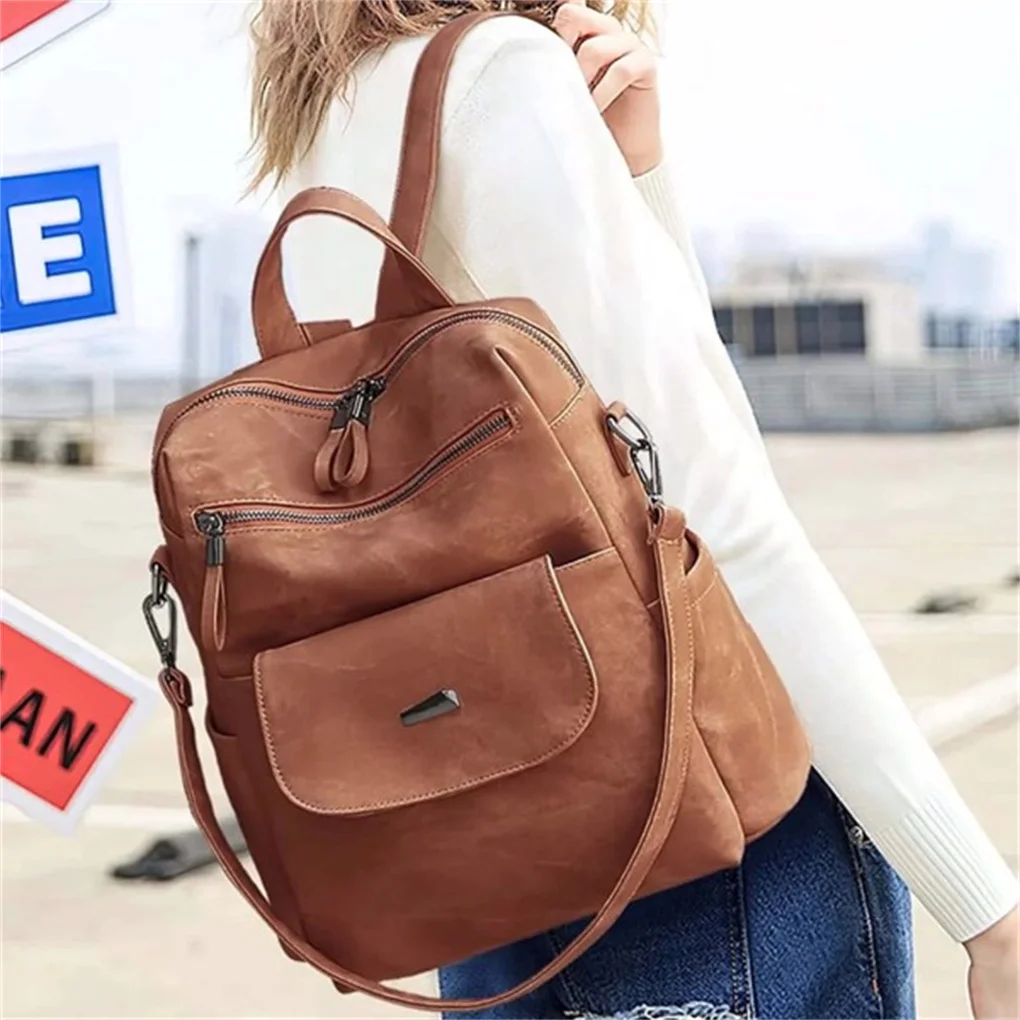
Best High-Capacity Option for Heavy Course Loads
Students in text-intensive programs like law, literature, or history often need substantially more carrying capacity without sacrificing style. This high-capacity backpack accommodates heavy course loads while maintaining fashionable appearance.
Key features include:
– Expanded main compartment (25-30 liters)
– Reinforced shoulder straps designed for heavier loads
– Sternum strap for additional stability
– Multiple compartments for organizing various materials
– Extra padding at back panel for comfort under weight
– Reinforced bottom panel with protective feet
– Heavy-duty hardware designed for frequent use
– Expandable water bottle pocket
Despite its increased capacity, this backpack maintains a relatively streamlined appearance through careful design. The additional volume is achieved through depth rather than bulk, preserving a flattering silhouette when worn. Strategic compression straps allow the bag to maintain its shape even when not fully loaded.
The internal organization system specifically addresses the challenges of carrying multiple heavy textbooks, with padded dividers to prevent books from damaging each other during transit. Reinforced stitching at all stress points ensures durability even when consistently carrying maximum loads.
For students regularly transporting substantial materials, these large leather backpacks provide the necessary capacity without the utilitarian appearance of traditional high-volume packs.
Best Tech-Friendly Design for Digital Students
Modern education increasingly revolves around technology, with many students carrying laptops, tablets, e-readers, and various accessories. This tech-optimized backpack specifically addresses the needs of digitally-focused students.
Key features include:
– TSA-compliant laptop compartment that opens flat (up to 15”)
– Tablet sleeve with protective microfiber lining
– Cable management system to prevent tangling
– Power bank pocket with cable pass-through
– RFID-blocking pocket for protecting digital information
– Padded compartments for headphones and peripherals
– Strategic internal routing for charging cables
– Water-resistant zippers to protect electronics
The design philosophy prioritizes both protection and accessibility. Premium padding safeguards valuable devices, while thoughtful organization ensures each item is immediately accessible when needed. Quick-access side entry allows device retrieval without opening the main compartment.
The exterior maintains sophisticated style despite the technical interior, avoiding the “gadget bag” appearance of more utilitarian options. Premium leather construction provides appropriate protection while projecting a more mature image than typical tech-oriented backpacks.
Students who prioritize digital tools will appreciate these 15-inch leather laptop backpacks designed specifically around technology organization and protection.
Best Weather-Resistant Option for All Seasons
Campus life requires navigating between buildings in all weather conditions. This weather-optimized backpack protects contents from the elements without sacrificing leather’s premium aesthetic.
Key features include:
– Specially treated leather with enhanced water resistance
– Sealed seams to prevent water penetration
– Water-resistant zippers with protective flaps
– Roll-top closure option for maximum weather protection
– Quick-dry interior lining that resists mildew
– Protected laptop compartment with additional water barriers
– Umbrella sleeve with drainage system
– Reflective elements for visibility in poor conditions
Despite these technical features, the backpack maintains a fashionable appearance suitable for campus environments. The weather protection elements integrate seamlessly into the design rather than appearing as obvious technical additions. The leather treatment enhances rather than diminishes the material’s natural beauty.
The interior organization specifically addresses weather-related concerns, with dedicated spaces for potentially damp items like umbrellas or water bottles, keeping them isolated from electronics and papers. The quick-dry lining prevents moisture buildup when the bag itself gets wet.
Understanding proper leather conditioning and waterproofing techniques helps maintain this weather resistance over time. Regular application of appropriate leather protectants enhances the natural water-resistant properties while preserving the material’s appearance and flexibility.
Best Budget-Friendly Quality Leather Option
Quality leather typically commands premium prices, but this budget-conscious option delivers genuine leather quality at a more accessible price point for students watching their spending.
Key features include:
– Genuine top-grain leather (not bonded or synthetic)
– Streamlined design that maximizes functionality with minimal materials
– Focused organization for essentials (laptop, books, small items)
– Reinforced stitching at critical stress points
– Basic but functional internal organization
– Classic design that won’t appear dated quickly
– Limited but versatile color options
– Simplified hardware that maintains durability
This backpack achieves its more accessible price point through focused design rather than quality compromise. By eliminating non-essential features and focusing on core functionality, it delivers genuine leather quality within a student-friendly budget. The design emphasizes durability at crucial stress points while simplifying less critical elements.
While it may lack some premium details of higher-priced options, this backpack delivers the core benefits of leather—durability, developing patina, and classic style—at a more attainable price point. For students making their first leather backpack purchase, it offers an excellent entry point to quality without overwhelming financial commitment.
14 Inch Leather Laptop Backpack, Brown Leather Backpack, Men's Leather Backpack, Vintage Leather Backpack
Price range: $177.28 through $199.12 Select options This product has multiple variants. The options may be chosen on the product pageCarry On Leather Backpack, Roll Top Leather Backpack
Price range: $77.76 through $96.48 Select options This product has multiple variants. The options may be chosen on the product pageDesigner Men's Backpack, Men's Leather Laptop Backpack, Men's Leather Work Backpack
Price range: $158.04 through $160.04 Select options This product has multiple variants. The options may be chosen on the product pageDesigner Mini Backpack, Mini Leather Backpack, Small Leather Sling Backpack, Women's Leather Backpack
Price range: $95.76 through $98.80 Select options This product has multiple variants. The options may be chosen on the product pageDesigner Mini Backpack, Designer Women's Backpack, Mini Leather Backpack, Women's Leather Backpack
Price range: $135.92 through $137.64 Select options This product has multiple variants. The options may be chosen on the product page15 Inch Leather Laptop Backpack, Leather Briefcase Backpack
$332.96 Select options This product has multiple variants. The options may be chosen on the product page
Best Convertible Design for Versatile Student Life
Student life demands flexibility as you move between different environments. This innovative convertible design transforms to match changing situations throughout your day.
Key features include:
– Configurable carrying options (backpack, messenger, briefcase)
– Hide-away straps that tuck away when not needed
– Quick-change mechanism that doesn’t compromise aesthetics
– Balanced design that functions well in all configurations
– Professional appearance in briefcase/messenger mode
– Comfortable ergonomics in backpack configuration
– Context-appropriate hardware that works across styles
– Consistent access to contents regardless of carrying method
This backpack excels at transitions between different environments—from casual classroom settings to formal presentations or interviews. The conversion mechanisms are thoughtfully integrated into the design, avoiding the awkward appearance of many convertible bags.
In backpack mode, it provides the hands-free convenience and weight distribution needed for navigating busy campus environments. When converted to briefcase or messenger style, it projects a more professional image appropriate for internships, presentations, or job interviews.
For students with varied daily schedules who need a bag that adapts to different contexts, these convertible leather backpacks provide maximum versatility without compromising on style or function in any configuration.
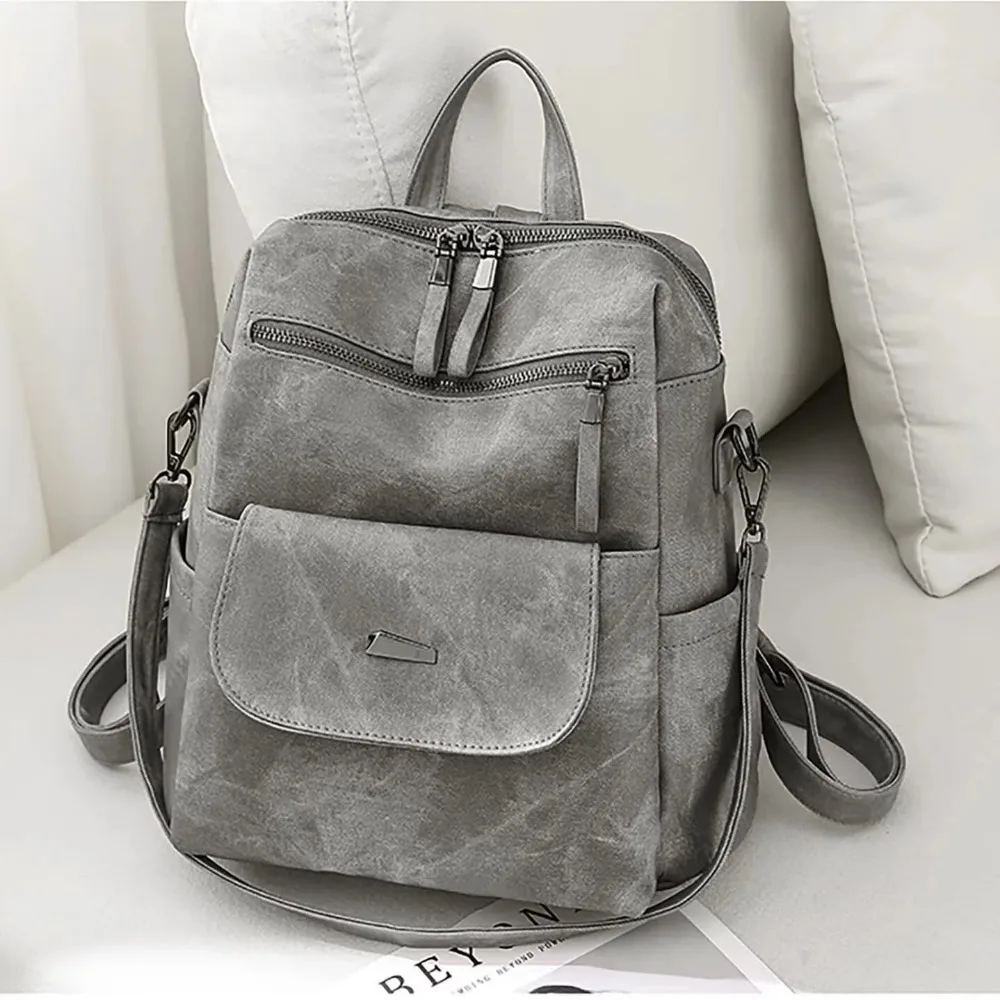
Styling Your Leather Backpack: From Lectures to Interviews
A quality leather backpack serves as more than just a functional item—it becomes part of your personal style statement. Understanding how to incorporate your backpack into different outfits maximizes its versatility across campus settings.
When selecting a leather backpack, consider your existing wardrobe palette. Neutral colors (black, brown, tan, navy) offer maximum versatility, while less conventional colors (burgundy, forest green, charcoal) can add distinctive character while still pairing well with most outfits.
For everyday campus wear, leather backpacks complement casual attire without appearing overly formal. They add a touch of sophistication to simple jeans and t-shirt combinations, and pair naturally with casual button-downs, chinos, and casual dresses.
As seasons change, your leather backpack adapts differently to your wardrobe. In fall and winter, it complements heavier materials like denim, wool, and corduroy. During spring and summer, it provides a grounding element to lighter fabrics and brighter colors. This year-round versatility makes leather backpacks particularly valuable for students with limited accessory budgets.
For maximum versatility, consider these complementary accessories:
– Leather key fob in matching color
– Simple leather bracelet or watch band
– Leather portfolio for important papers
– Subtle leather accents on other everyday items
Learning to style leather backpacks for school environments appropriately helps you maximize your investment while expressing your personal aesthetic. The right backpack should enhance rather than compete with your overall look, serving as a sophisticated complement to your individual style choices.
Campus to Career: Styling for Different Settings
As you move between different environments, your leather backpack can adapt accordingly with thoughtful styling choices:
Casual Campus Days
– Pair with: Jeans, t-shirt or casual button-down, sneakers or casual boots
– Carry style: Traditional backpack position, both straps utilized
– Complementary accessories: Simple watch, casual bracelet
– Appropriate settings: Lectures, study sessions, casual campus activities
Presentations and Semi-Formal Events
– Pair with: Chinos or dress pants, button-down shirt or blouse, blazer, dress shoes
– Carry style: Single shoulder or hand-carried by top handle
– Complementary accessories: Minimal jewelry, professional watch
– Appropriate settings: Class presentations, department events, career fairs
Internships and Interviews
– Pair with: Business casual or business attire
– Carry style: Brief/messenger configuration if convertible, or hand-carried
– Complementary accessories: Quality pen, professional portfolio
– Appropriate settings: Job interviews, internships, networking events
Weekend and Social Activities
– Pair with: Casual attire, statement pieces, personal style elements
– Carry style: Relaxed backpack position or cross-body if convertible
– Complementary accessories: More expressive personal accessories
– Appropriate settings: Weekend activities, social events, travel
Learning to wear backpacks with leather jackets and other statement pieces requires balancing proportions and complementary leather tones. When pairing leather items, aim for coordination rather than exact matching—slight variations in tone create more sophisticated combinations than perfectly matched pieces.
Seasonal adaptations also influence styling choices. In warmer weather, lighter-colored leather backpacks complement seasonal palettes, while darker tones provide grounding elements to winter wardrobes. The developing patina of quality leather creates natural seasonal transitions as your backpack evolves over time.
Essential Care Guide: Maintaining Your Leather Backpack
Proper maintenance transforms a leather backpack from a temporary accessory to a lasting investment. With appropriate care, premium leather improves with age, developing a rich patina that tells the story of your academic journey.
Basic leather maintenance requires minimal time investment—just a few minutes weekly and occasional deeper care. This simple routine preserves both appearance and structural integrity:
Daily Care (30 seconds)
– Empty completely at day’s end to maintain shape
– Wipe with soft, dry cloth to remove surface dust
– Allow to air out in well-ventilated area
Weekly Maintenance (2-3 minutes)
– Clean with leather-specific wipes or slightly damp cloth
– Pay special attention to handles and high-contact areas
– Check and clear zipper tracks of debris
– Inspect for any developing issues (loose threads, etc.)
Monthly Deep Care (10-15 minutes)
– Clean thoroughly with appropriate leather cleaner
– Apply leather conditioner to prevent drying
– Address any scuffs or minor damage
– Treat hardware with appropriate metal cleaner if needed
Seasonal Storage (30 minutes)
– Deep clean all surfaces and interior
– Condition thoroughly before extended storage
– Stuff with acid-free tissue to maintain shape
– Store in breathable cloth bag away from direct sunlight
For detailed guidance on keeping your backpack in optimal condition, our comprehensive leather backpack care and maintenance guide provides step-by-step instructions for addressing specific conditions and challenges.
Many students worry that leather care is complicated, but basic maintenance requires no special expertise—just attention and consistency. The small time investment delivers substantial returns through extended lifespan and preserved appearance. Quality leather actually becomes easier to maintain over time as it develops natural oils and character.
Daily and Weekly Maintenance Routines
Incorporating simple leather care into your routine prevents most common issues before they develop:
Daily Quick Care
1. Empty your backpack completely each evening
2. Wipe down exterior with a clean, dry cloth
3. Leave unzipped in well-ventilated area overnight
4. Avoid storing in damp areas like bathrooms
Addressing Common Campus Situations
– Light rain exposure: Wipe dry with absorbent cloth, allow to air dry naturally
– Minor spills: Blot (don’t rub) immediately with clean cloth
– Campus dirt: Brush with soft brush when dry, then wipe with slightly damp cloth
Weekly Maintenance Steps
1. Clean surface with leather-specific wipes or damp cloth with mild soap
2. Pay special attention to handles, strap connections, and bottom
3. Remove dust from crevices using soft brush
4. Check and clean zipper tracks with soft toothbrush
5. Apply small amount of leather conditioner if leather feels dry
Quick Fixes for Minor Issues
– Small scratches: Rub gently with fingertip to warm leather and blend marks
– Dry spots: Apply tiny amount of leather conditioner to specific area
– Water spots: Allow to dry naturally, then condition entire panel
– Loose thread: Don’t pull; trim carefully or have professionally repaired
Most maintenance tasks require only basic supplies:
– Soft microfiber cloths
– Leather-specific cleaning wipes
– Gentle leather cleaner
– Quality leather conditioner
– Soft-bristled brush
With consistent basic care, most leather backpacks require deeper conditioning only every 3-6 months, depending on climate and use conditions. This minimal maintenance schedule is manageable even for busy students and preserves your investment with minimal effort.
Seasonal Care and Long-Term Protection
Between semesters or during extended breaks, taking time for deeper leather care ensures long-term preservation of your backpack:
Semester Break Deep Cleaning
1. Empty all compartments completely
2. Vacuum interior using upholstery attachment
3. Clean leather thoroughly with appropriate cleaner
4. Address any stains or problem areas
5. Apply quality leather conditioner
6. Allow conditioner to absorb completely (24 hours)
7. Buff gently with soft cloth for natural shine
Conditioning Process
1. Test conditioner on inconspicuous area first
2. Apply small amount to clean cloth (not directly to leather)
3. Work into leather using gentle circular motions
4. Pay special attention to flex points and dry areas
5. Allow to absorb fully before applying second light coat if needed
6. Wipe away any excess after absorption
Seasonal Considerations
– Winter preparation: Apply water-resistant treatment before winter weather
– Summer storage: Condition thoroughly, store away from direct sunlight
– Humid conditions: Use anti-mildew products for leather, check frequently
– Dry climates: Condition more frequently to prevent leather from drying out
Storage During Extended Breaks
1. Clean and condition thoroughly
2. Stuff with acid-free tissue paper to maintain shape
3. Store in breathable cotton bag, never plastic
4. Place in cool, dry location away from direct sunlight
5. Check occasionally during extended storage
6. Re-condition lightly before returning to use
Rehabilitation for Neglected Leather
1. Clean thoroughly with leather-specific cleaner
2. Apply leather conditioner in thin layers, allowing absorption between applications
3. Repeat conditioning process several times if leather is severely dried
4. Address specific damage with appropriate techniques or professional repair
5. Establish regular maintenance routine going forward
While quality leather is remarkably forgiving, addressing minor issues quickly prevents them from becoming permanent damage. With proper seasonal care, your leather backpack will continue improving in appearance throughout your academic career and beyond.
FAQ: Common Student Questions About Leather Backpacks
Aren’t leather backpacks heavy compared to canvas or nylon options?
While leather is naturally heavier than synthetic materials, the difference is less significant than many expect. A well-designed leather backpack typically weighs 2.5-3.5 pounds empty, compared to 1-2 pounds for synthetic alternatives. This difference becomes negligible when carrying a full day’s worth of books and technology. Additionally, quality leather backpacks distribute weight more effectively through superior construction, often feeling more comfortable despite the slight weight increase.
How long will a leather backpack actually last with student use?
With proper care, a quality full-grain leather backpack can easily last throughout your entire academic career and well into professional life. Many premium leather backpacks see 10+ years of regular use while maintaining both functionality and appearance. The key factors affecting longevity are leather quality, construction methods, maintenance routine, and use conditions. Even with daily student use, which is more demanding than occasional use, a well-made leather backpack should easily last 5-8 years before needing any significant repairs.
Are leather backpacks really worth the higher price for students on a budget?
When evaluated on cost-per-use, quality leather backpacks often represent better value than cheaper alternatives that require frequent replacement. A $250 leather backpack used daily for five years costs approximately 14 cents per use. Meanwhile, replacing a $50 synthetic backpack annually for five years results in a comparable cost per use but with the inconvenience of shopping for replacements and adapting to new bags. Additionally, leather backpacks retain resale value should your needs change, while worn synthetic backpacks have essentially no secondary market value.
Which academic majors benefit most from specific backpack features?
Different academic focuses benefit from specialized features:
– Engineering/Architecture: Larger laptop compartments for CAD work, reinforced structure for tools and models
– Arts: Specialized protection for portfolios, materials storage, water-resistant features
– Business: Professional appearance, organization for documents, convertible carrying options
– Sciences: Durable construction for lab equipment, water-resistant features, easy-clean surfaces
– Humanities: High-volume book storage, comfortable carrying for heavy loads, document organization
What about ethical concerns regarding leather products?
Many premium leather companies now emphasize responsible sourcing and production methods. For ethically concerned students, options include:
– Brands with transparent supply chains and ethical manufacturing certification
– Vintage or second-hand leather goods that don’t create new demand
– Vegetable-tanned leathers using traditional, less chemical-intensive methods
– Hybrid products using minimal leather combined with sustainable materials
– High-quality vegan alternatives with similar durability characteristics
How do you travel with a leather backpack?
When traveling with a leather backpack:
– Apply leather protector before trips to guard against varied conditions
– Avoid checking leather bags when flying—always carry on
– Bring a lightweight rain cover for unexpected weather
– Allow bag to fully air dry if it gets wet before packing
– Consider a dust bag for protection when storing in hotel rooms
Is a Leather Backpack Really Worth It for Students?
When evaluating the true value of a leather backpack for student life, several factors deserve honest consideration:
Initial Investment vs. Long-Term Economics
Quality leather backpacks typically cost $150-400, representing a significant initial investment for most students. However, when divided over a 4+ year college career, this amounts to $37-100 per year—comparable to replacing lower-quality bags annually. Additionally, leather backpacks often continue serving well into professional life, further extending their value proposition.
Style Longevity vs. Fashion Trends
While fashion-focused backpacks may look dated after a few seasons, well-designed leather backpacks offer timeless appeal that transcends trends. This classic quality allows them to remain appropriate throughout changing campus fashion cycles and transition seamlessly into professional environments after graduation.
Adaptability Across Environments
Few accessories transition as effectively between different settings as quality leather backpacks. From casual campus environments to professional interviews, a well-chosen leather backpack remains appropriate where other bags would appear out of place. This adaptability becomes increasingly valuable as students progress toward graduation and professional opportunities.
Sustainability Considerations
In an era of increasing environmental awareness, the “buy once, cry once” philosophy of quality leather goods offers meaningful advantages. A single well-made leather backpack that lasts 10+ years generates significantly less environmental impact than a series of short-lived alternatives. Additionally, quality leather can often be repaired rather than replaced when damaged.
Personal Connection and Character Development
Perhaps the most unique aspect of leather backpacks is how they evolve with their owners. The patina that develops through years of use creates a visual record of your experiences—something synthetic materials can never replicate. Many graduates report strong attachment to backpacks that accompanied them throughout their academic journeys.
For most students, the value question ultimately extends beyond simple economics to include considerations of personal style, environmental impact, and the unique relationship we develop with well-made items that accompany us through important life phases. While not every student will prioritize these factors equally, those who appreciate quality craftsmanship and timeless design typically find leather backpacks to be worthwhile investments in both their present needs and future aspirations.
At Summit Carry, we believe that choosing a quality leather backpack represents not just a practical decision but an investment in both your student experience and professional future—creating a companion piece that evolves alongside your journey from campus to career.
